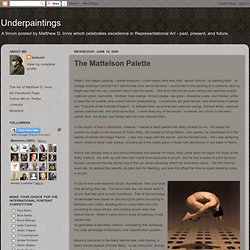

Jim Serrett Studio: Primary Color Triads. All colors can be mixed by simply using the three primary colors: red, blue, and yellow, as we know.

However there are a great variety of red, yellow and blue hues available to the artist and to gain an understanding of the diversity and range of those primary triads you really have to mix them. Mixing colors with a limited palette will not only give you great insight into color mixing but produce inherent color harmony. Select three variations and experiment. These color wheels are a triad of Yellow Ochre, Burnt Sienna and Ivory Black. I have really become fascinated with these three colors. A good painter needs only three colours: black, white and red. Draughtsmen may be made, but colourists are born. - Eugene Delacroix Hue -pure color Tint - hue with white Tone- hue with gray Shade - hue with black Value - the lightness or darkness of a color Explore - Question - Learn - - Enjoy, Jim. WetCanvas: Online Living for Artists. ArtsSchool Online: Color Theory & Mixing: 16 Lessons in Color Theory. Les mondes de la couleur, les couleurs du monde.
The Mattelson Palette. When I first began painting, I asked everyone I could harass what was their "secret formula" for painting flesh.

(A college professor had told me I had horrible color sense because I used brown in the painting of a costume, and my fragile ego had me very uncertain about color for years). One artist told me he used nothing but cadmium scarlet, cadmium green, and white. Another, mars orange, Winsor orange, sap green, dioxazine purple, and titanium white (I used this for a while, over a burnt sienna underpainting- I sometimes got good results, and other times it looked like "TheLand of the Sherbert People"). A different artist recommended cadmium orange, titanium white, cadmium yellow, cadmium red, and ultramarine blue. I never liked any of the results I achieved, so I stuck to the basic yellow, blue, red recipe, and fiddled with the hues now and then. In the studio of Marvin Mattelson, however, I learned a flesh palette that really clicked for me. The following row is the yellow string.
Munsell color system. The Munsell color system, showing: a circle of hues at value 5 chroma 6; the neutral values from 0 to 10; and the chromas of purple-blue (5PB) at value 5. Several earlier color order systems had placed colors into a three-dimensional color solid of one form or another, but Munsell was the first to separate hue, value, and chroma into perceptually uniform and independent dimensions, and was the first to systematically illustrate the colors in three-dimensional space.[1] Munsell’s system, particularly the later renotations, is based on rigorous measurements of human subjects’ visual responses to color, putting it on a firm experimental scientific basis. Because of this basis in human visual perception, Munsell’s system has outlasted its contemporary color models, and though it has been superseded for some uses by models such as CIELAB (L*a*b*) and CIECAM02, it is still in wide use today.[2] Explanation[edit] Munsell’s color sphere, 1900.
Hue[edit] Value[edit] Chroma[edit] Professor Albert H. Dotapea. The Reilly Papers.